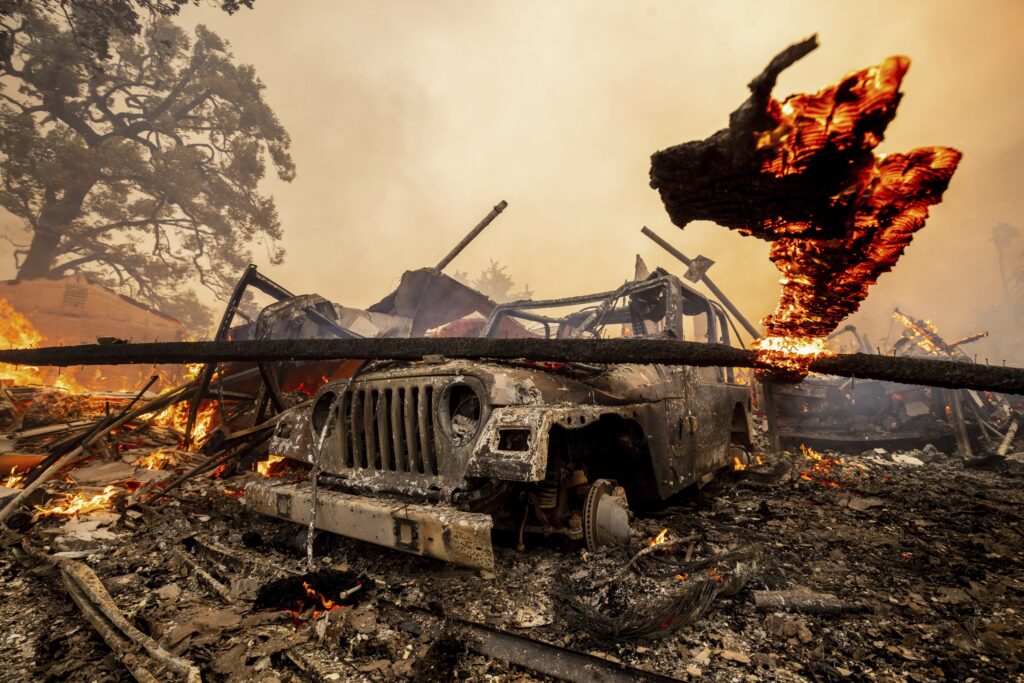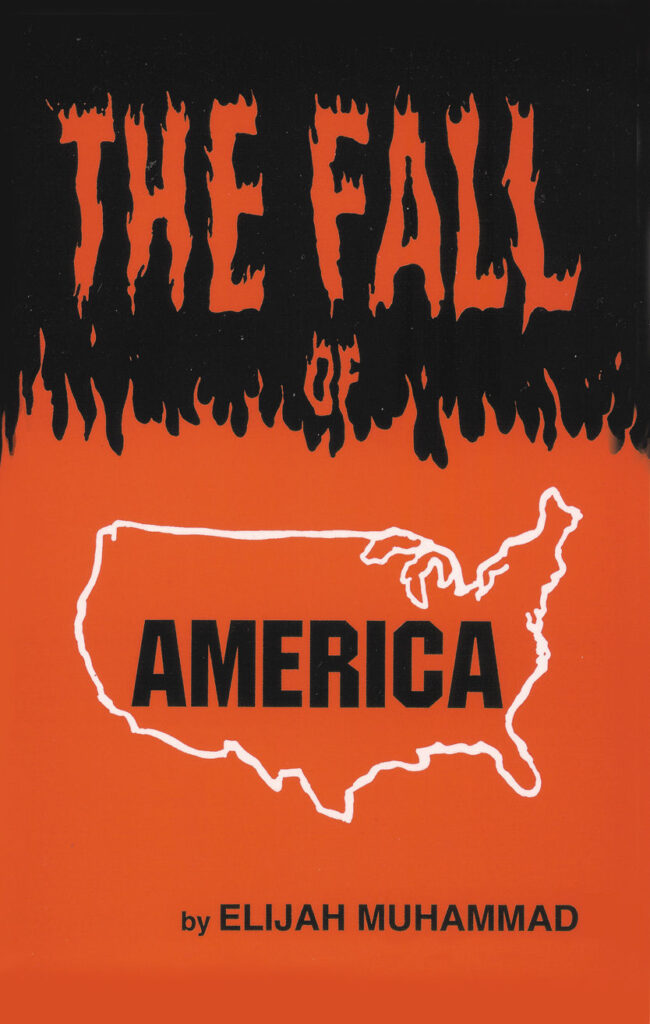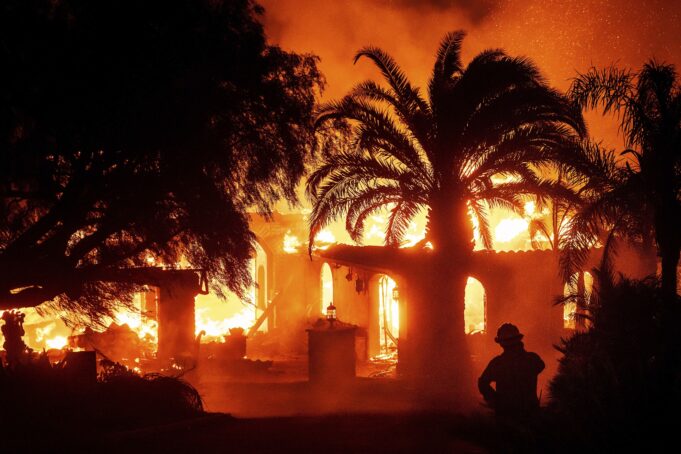Fires raged on both coasts, fed by high winds in the West and a dry spell in the East, bearing witness to the Most Honorable Elijah Muhammad’s warnings that God would curtail America on her sides. The Honorable Minister Louis Farrakhan, his National Representative, has warned for decades to “watch the weather.”
It took about a week for firefighters to get a mountain fire in Southern California under control. The wildfire started the morning of Nov. 6 in Ventura County, near the city of Camarillo, northwest of Los Angeles. The cause of the fire has not been determined.
As the day progressed, the fire burned out of control. It had already burned more than 8,800 acres and forced the evacuation of more than 10,000 people, according to a Nov. 6 statement from Governor Gavin Newsom securing federal assistance to help suppress the fire.
The Associated Press reported that the fire “grew from less than half of a square mile to 16 square miles (62 square kilometers) in little more than five hours.”

The National Weather Service issued Red Flag warnings for Ventura and Los Angeles counties that lasted days. A Red Flag warning is issued when “warm temperatures, very low humidities, and stronger winds are expected to combine to produce an increased risk of fire danger,” according to the National Weather Service.
An air quality alert was also issued.
On Nov. 7, Gov. Newsom declared a state of emergency in Ventura County. Thousands remained under evacuation orders. The governor issued an executive order to support fire response and recovery efforts on Nov. 8. He shared that the fire caused widespread hazardous structural debris possibly containing dangerous toxins.
Firefighters were still battling the blaze on Nov. 12. By that night, the fire had burned 20,630 acres and was 54 percent contained, according to a post on the Ventura County Fire Department’s Facebook page.
The mountain fire injured at least six people. It affected homes, ranches and agricultural areas near Camarillo. Photos depicted horses trotting amidst the plumes of smoke. Schools closed, and power was shut off for nearly 70,000 customers in five counties, Southern California Edison reported on Nov. 7.
The fire destroyed or damaged at least 274 structures, including homes and businesses, based on numbers from a Nov. 11 news conference. Also at the news conference, Korinne Bell, Ventura County’s Agricultural Commissioner, shared an estimate of over $6 million in agricultural damage, at only a quarter of it surveyed.
Days before the mountain fire, at the governor’s direction, the California Office of Emergency Services prepared for dangerous fire weather forecasts by securing 48 pieces of firefighting equipment, nine helicopters and over 100 personnel in 19 counties across the state, according to the governor’s Nov. 6 statement.
Firefighters in Los Angeles County battled a wildfire that burned near multimillion-dollar properties, according to the Associated Press. Officials urged residents to shelter in place, as the fire burned two structures and about 50 acres.
As of Nov. 12, wildfires burned more than 1,040,566 acres in California this year, compared to 308,897 acres by this time last year, according to the California Department of Forestry and Fire Protection.
Across the country, in the Northeast, drought has contributed to numerous wildfires, with states such as New Jersey experiencing consecutive wildfires.

On Nov. 8, the New Jersey Forest Fire Service sent a wildfire alert for Englewood Cliffs, a borough in Bergen County, N.J. The fire affected 39 acres.
On that same day, an alert was sent about a wildfire in Pompton Lakes, a borough in Passaic County, N.J. The fire was named “Cannonball 3 Wildfire.” It blazed across 181 acres and threatened 55 structures.
The following day, yet another alert was sent out about the “Jennings Creek Wildfire” in West Milford, a township in Passaic County. The fire spread across 3,500 acres and threatened 25 structures. It also affected Orange County, New York. It killed at least one person. Several roads and trails were closed.
The Cannonball 3 Wildfire was fully contained by the evening of Nov. 10. Two days later, the Jennings Creek Wildfire was 30 percent contained. The cause of both fires was still under investigation.
In New York, brush fires broke out in Prospect Park in Brooklyn and Highbridge Park in The Bronx on Nov. 8. Temperatures in the city have been warmer than normal, according to data from the University at Albany.
“(Five) 5 of the past eight days have had highs nearly 20F above normal. There has been no appreciable rainfall for about 40 days, and Brooklyn is ~9” below normal over 90 days,” New York’s State Weather Risk Communication Center, located at the university, posted on X (formerly Twitter).
New York City’s Emergency Management Department warned residents of an air quality health advisory due to smoke from both the New Jersey fires and the city’s own fires. The city saw more brush fires over the next few days.
Additional brush fires occurred throughout Massachusetts. In October, the state’s Department of Fire Service recorded 200 wildland fires, a 1,200 percent increase from the month’s average total of 15 fires, according to USA Today. Officials monitored about 84 brush fires in Connecticut. Parts of Virginia and West Virginia received wildfire warnings.
From Nov. 8 to Nov. 13, the National Weather Service issued Red Flag warnings and statements concerning an elevated risk of wildfire spread in New York City, Albany, N.Y., and Mount Holly, N.J. The service attributed the wildfire outbreaks to high wind gusts combined with dry conditions and average humidity.
Cities and states in the Northeast have experienced record-setting dry spells with over 30 days of no rain and very little rain since September. Parts of New York and New Jersey saw some rain on Nov. 11 and 12, but not enough to put an end to the fires.
Over 93 percent of the Northeast is abnormally dry, more than half is suffering moderate drought conditions and more than 26 percent is suffering from severe or extreme drought, according to the U.S. Drought Monitor.
The beginning of sorrows
In the book, “The Fall of America,” the Most Honorable Elijah Muhammad, Eternal Leader of the Nation of Islam, warned that God would use the forces of nature to curtail America on all her sides.
“And these judgments would push the people into the center of the country, and there they would realize that it is Allah (God) Who is bringing them and their country to a naught,” he wrote in Chapter 35, titled, “America Surrounded with The Judgment of Allah,” on page 154.
His National Representative, the Honorable Minister Louis Farrakhan, further warned America of God’s judgment hitting the country on her sides.
“We are living at a time that was described by Jesus in these words: ‘If those days were not shortened for his elect sake, no flesh would be saved.’ We know that we have now entered that period when we witnessed a tsunami killing over 200,000 people in Asia; an earthquake in Pakistan;
Storms raging throughout America, fire on one side, water on the other, snow, cold, ice in between; and the President of the United States unraveling in front of our eyes,” he said in a message, “The Beginning of Sorrows,” delivered on March 5, 2006, at Life Center Church in Chicago.
“Jesus prophesied of famine, pestilence and earthquakes in diverse places—but he said this is only the beginning of sorrow. I wish I could tell you today that there are good times ahead, but there are no more good times for the United States of America,” the Honorable Minister Louis Farrakhan warned.













